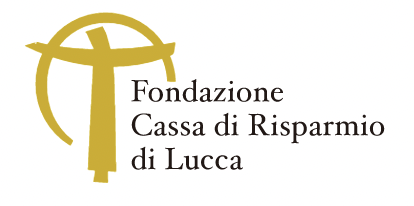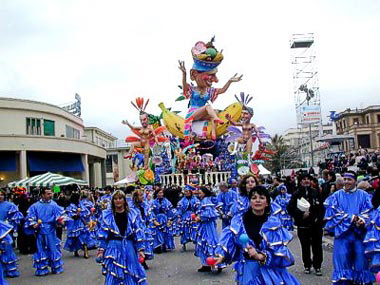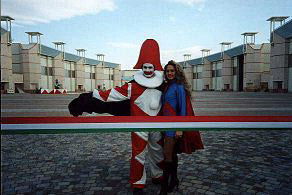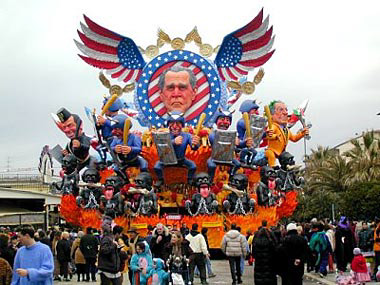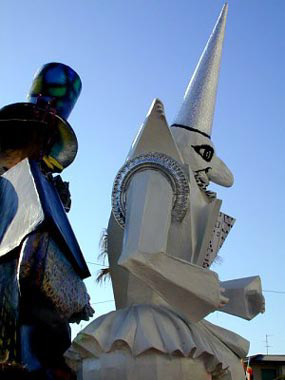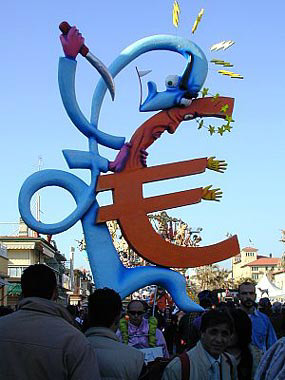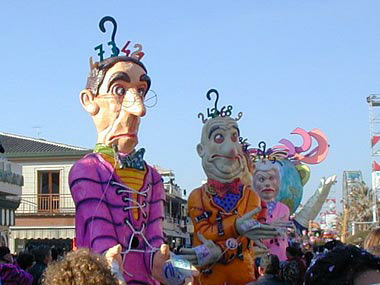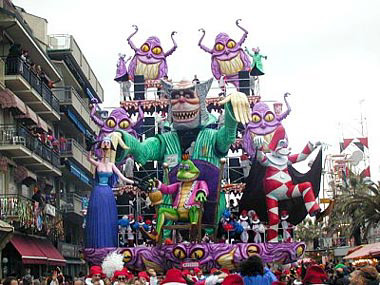
The carnival of Viareggio is the most important and spectacular of its kind in Tuscany , and among one of the most famous in Europe. The avenues running along the sea in this town of Versilia are hosts to a procession of great allegoric floats made out of papermache which move together with the big group Masquerades, each consisting of eight elements about three meters tall. The Carnival Foundation awards a prize to the best float in each category and to the most beautiful big group masquerade. On each float there is a masquerade of 200 elements and a group of a minimum of 10 musicians. A team of 20-30 people work the movements of the figures on the floats. From the 1970’s onward, a dominant allegoric theme has been that of political satire which works side by side with fantastic and evasive themes.
The floats are made throughout the year in the Carnival Citadel , an important structure inaugurated in December 2001.The carnival museum resides here.
The procession of the floats is not the only attraction at the Carnival of Viareggio: at night, the festivities continue in the streets of the town’s quarters which fill up with people in fancy dress and music into the small hours. There are also many parties in clubs and pubs and other cultural and amusing initiatives such as the “Pop song festival”.
The locals of the Caffè del Casino first discussed proposals for a carnival procession featuring floats, flowers and fancy dress in 1873. The idea captured the inhabitants immediately, and in the years immediately following, they combined gentlemen’s coaches with carts. A decade passed by after the float procession in Via Regia before seeing the first allegoric float parade. In 1883, the employees of the Regia Marina proposed “I Quattro mori”, a life- size reproduction of the Livornese monument for Ferdinando II. Today, floats are based on the use of layers of papermache, which is a preparation of water, glue, plastercast and paper. You then procede with its pictorial decoration and finish off with a coating of glossy varnish to protect the work.
Since 1953, processions with a set theme have sometimes been experienced, but normally the floats deal with disparate topics, although since the 1970’s, political satire has been the most popular one. The Carnival parade is accompanied by the official band, the “Maschereide” ( they substituted the precedent band , the “Libecciata” in 1989), and its characteristic mask “Burlamacco”, thought up by Uberto Sonetti in 1931.
link to the official programme FONDAZIONE CARNEVALE DI VIAREGGIO
Piazza Mazzini, 22
c/o Palazzo delle Muse 55049
Viareggio
info@ilcarnevale.com
Tel 0584 962568
Fax 0584 47077
www.viareggio.ilcarnevale.com tradition-religion Viareggio Carnival Fondazione del Carnevale di Viareggio Renzo Pellegrini, I 120 anni del Carnevale di Viareggio
Casa editrice Pezzini Viareggio 1994
Gallery:
Details:
The carnival of Viareggio is the most important and spectacular of its kind in Tuscany , and among one of the most famous in Europe. The avenues running along the sea in this town of Versilia are hosts to a procession of great allegoric floats made out of papermache which move together with the big group Masquerades, each consisting of eight elements about three meters tall. The Carnival Foundation awards a prize to the best float in each category and to the most beautiful big group masquerade. On each float there is a masquerade of 200 elements and a group of a minimum of 10 musicians. A team of 20-30 people work the movements of the figures on the floats. From the 1970’s onward, a dominant allegoric theme has been that of political satire which works side by side with fantastic and evasive themes.
The floats are made throughout the year in the Carnival Citadel , an important structure inaugurated in December 2001.The carnival museum resides here.
The procession of the floats is not the only attraction at the Carnival of Viareggio: at night, the festivities continue in the streets of the town’s quarters which fill up with people in fancy dress and music into the small hours. There are also many parties in clubs and pubs and other cultural and amusing initiatives such as the “Pop song festival”.
Renzo Pellegrini, I 120 anni del Carnevale di Viareggio
Casa editrice Pezzini Viareggio 1994
by car: A11 motorway, exit Viareggio. Parking at thre “Pineta di ponente”.
public transport: trains and buses from Lucca.
FONDAZIONE CARNEVALE DI VIAREGGIO
Piazza Mazzini, 22
c/o Palazzo delle Muse 55049
Viareggio
info@ilcarnevale.com
Tel 0584 962568
Fax 0584 47077
Fondazione del Carnevale di Viareggio
The locals of the Caffè del Casino first discussed proposals for a carnival procession featuring floats, flowers and fancy dress in 1873. The idea captured the inhabitants immediately, and in the years immediately following, they combined gentlemen’s coaches with carts. A decade passed by after the float procession in Via Regia before seeing the first allegoric float parade. In 1883, the employees of the Regia Marina proposed “I Quattro mori”, a life- size reproduction of the Livornese monument for Ferdinando II. Today, floats are based on the use of layers of papermache, which is a preparation of water, glue, plastercast and paper. You then procede with its pictorial decoration and finish off with a coating of glossy varnish to protect the work.
Since 1953, processions with a set theme have sometimes been experienced, but normally the floats deal with disparate topics, although since the 1970’s, political satire has been the most popular one. The Carnival parade is accompanied by the official band, the “Maschereide” ( they substituted the precedent band , the “Libecciata” in 1989), and its characteristic mask “Burlamacco”, thought up by Uberto Sonetti in 1931.


